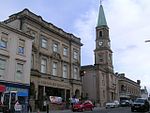Monkland Canal

The Monkland Canal was a 12+1⁄4-mile-long (19.7 km) canal designed to bring coal from the mining areas of Monklands to Glasgow in Scotland. In the course of a long and difficult construction process, it was opened progressively as short sections were completed, from 1771. It reached Gartcraig in 1782, and in 1794 it reached its full originally planned extent, from pits at Calderbank to a basin at Townhead in Glasgow; at first this was in two sections with a 96-foot (29 m) vertical interval between them at Blackhill; coal was unloaded and carted to the lower section and loaded onto a fresh barge. Locks were later constructed linking the two sections, and the canal was also connected to the Forth and Clyde Canal, giving additional business potential. Maintaining an adequate water supply was a problem, and later an inclined plane was built at Blackhill, in which barges were let down and hauled up, floating in caissons that ran on rails. Originally intended as a water-saving measure to be used in summer only, the inclined plane was found to pass barges more quickly than through the locks and may have been used all the year. In the second and third decades of the nineteenth century, technical advances in iron smelting coupled with fresh discoveries of abundant iron deposits and coal measures encouraged a massive increase in industrial activity in the Coatbridge area, and the Canal was ideally situated to feed the raw materials and take away the products of the industry. The development of railways reduced the competitiveness of the canal, and eventually it was abandoned for navigation in 1952, but its culverted remains still supply water to the Forth and Clyde Canal. Much of the route now lies beneath the course of the M8 motorway, but two watered sections remain, and are well stocked with fish.
Excerpt from the Wikipedia article Monkland Canal (License: CC BY-SA 3.0, Authors, Images).Monkland Canal
The North Calder Heritage Trail,
Geographical coordinates (GPS) Address Nearby Places Show on map
Geographical coordinates (GPS)
| Latitude | Longitude |
|---|---|
| N 55.85075 ° | E -3.9948333333333 ° |
Address
The North Calder Heritage Trail
The North Calder Heritage Trail
ML6 9RQ
Scotland, United Kingdom
Open on Google Maps







